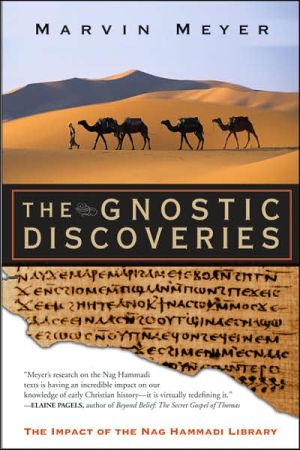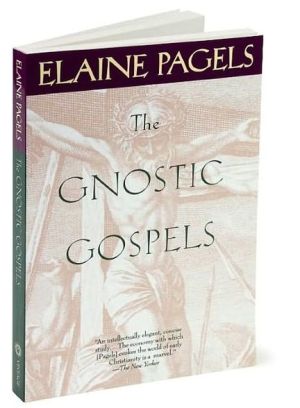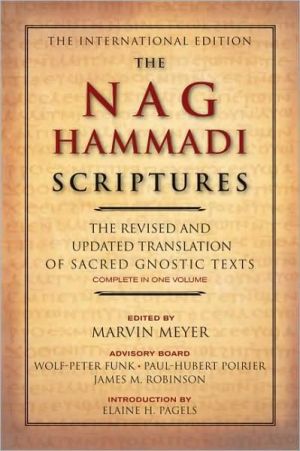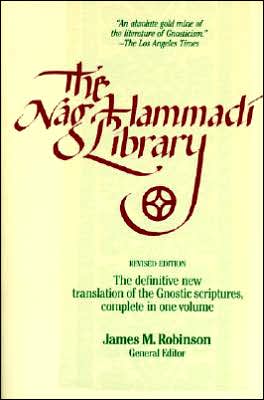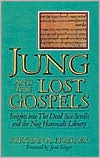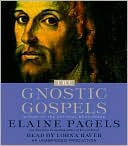Gnostic Discoveries: The Impact of the Nag Hammadi Library
The Meaning of the Nag Hammadi, now in paperback opens the with the thrilling adventure story of the discovery of the ancient Papyrii at Nag Hammadi. Muhammad Ali, the fellahin, discovered the sealed jar, he feared that it might contain a jinni, or spirit, but also had heard of hidden treasures in such jars. Greed overcame his fears and when he smashed open the jar, gold seemed to float into the air. To his disappointment, it was papyrus fragmenst, not gold, but for scholars around the world,...
Search in google:
The Meaning of the Nag Hammadi, now in paperback opens the with the thrilling adventure story of the discovery of the ancient Papyrii at Nag Hammadi. Muhammad Ali, the fellahin, discovered the sealed jar, he feared that it might contain a jinni, or spirit, but also had heard of hidden treasures in such jars. Greed overcame his fears and when he smashed open the jar, gold seemed to float into the air. To his disappointment, it was papyrus fragmenst, not gold, but for scholars around the world, it was invaluable.Meyer then discusses the pre–Christian forms of wisdom that went onto influence what Christians believe today. In addition, some Nag Hammadi texts are attributed to Valentinus, a man who almost became Pope, and whose rejection changed the church in significant ways. Text by text, Meyer traces the history and impact of this great find on the Church, right up to our current beliefs and popular cultural fascination with this officially suppressed secret knowledge about Jesus and his followers. Publishers Weekly Before the discovery of the Nag Hammadi documents in the 1940s, Gnosticism was considered to be a form of anti-Christian heresy taught by some early church fathers and condemned by others. Modern readers depended on secondary works condemning Gnosticism in order to understand its proponents' point of view. But with the unearthing of the Gnostic texts at Nag Hammadi, scholars have a better idea of the scope and direction of Gnostic teaching in the early years of Christianity as told by its adherents. Meyer, professor of Bible and Christian studies at Chapman University in California, boasts nine previous publications on the subject and demonstrates a deep understanding of both the history and content of the documents. After briefly recounting their discovery, he analyzes their content, sorting through the teachings and relating them, not just to the biblical text, but even to the bestselling novel The Da Vinci Code. Although there is no new material, the author's concise presentation will appeal to many readers. Meyer writes clearly, bringing both the people and the times of the early Gnostic writings to life and making them accessible to scholar and layperson alike. (Nov.) Copyright 2005 Reed Business Information.
The Gnostic Discoveries\ The Impact of the Nag Hammadi Library \ \ By Marvin Meyer \ HarperCollins Publishers, Inc.\ Copyright © 2005 Marvin Meyer\ All right reserved.\ ISBN: 0060821086 \ \ \ Chapter One\ Fertilizer, Blood Vengeance, and Codices\ The Discovery of the Nag Hammadi Library\ \ About 600 kilometers south of Cairo and 125 kilometers north of Luxor, at the big bend in the Nile River in Upper Egypt, lies the city of Nag Hammadi. The Nile Valley is particularly scenic there, and the cliffs that flank the river loom large and are close to the river, giving an impressive definition to the inhabited valley. This valley, watered from ancient times by the Nile, is the "black land," in ancient Egyptian Kemit or Kemi, which was the name of the land of Egypt. The modern name, Egypt, derives from the Greek Aigyptos, as do the words "Coptic" and "Copt," so that by etymology Coptic means Egyptian and a Copt is an Egyptian person.\ The fertile "black land" of Egypt was contrasted in ancient Egyptian mythological texts with the "red land," that is, the desert land beyond the waters of the Nile River. Before the Aswan High Dam was constructed to control the flow of the Nile, the river typically inundated each year, more or less on schedule. Water marks remaining on older mud-brick buildings in southern Egypt show how high the water used to come during the season of inundation. The inundation of the Nile was judged to be a gift of the divine, since life-giving water and nutrients borne by the water flooded over the land and brought fertility to the soil. The red land extended beyond the reach of the water into the desert that surrounds Egypt. In mythological terms, the black land was the land of the god Osiris; the red land was the land of his hostile brother Seth. As Osiris and Seth were rivals in Egyptian mythology, so the black land, the rich, moist soil, struggled with the red land, the dry desert sands, for the maintenance of life. It was in the vicinity of the city of Nag Hammadi that the Coptic texts of the Nag Hammadi library were discovered, buried in the dry sand of the red land near the edge of the black land.\ From early days the Nag Hammadi region was known for a Christian presence.1 According to tradition, St. Mark brought the Christian gospel to Egypt when he arrived in Alexandria, in the Nile Delta, in the first century c.e. Christianity spread throughout Egypt and beyond, to Ethiopia and elsewhere in Africa, and Egyptian Christianity took a variety of forms and expressed itself with a variety of spiritualities: Jewish Christian, apocalyptic, Alexandrian, gnostic, Manichaean, monastic. The richness of Christianity in Egypt rests in large part in the diversity of its early manifestations. Some of this diversity is evident in the Nag Hammadi library and the related texts discovered along the banks of the Nile River.\ The Discovery of the Nag Hammadi Codices\ In about December of 1945, as Muhammad Ali of the al-Samman clan has told his story to James M. Robinson, several Egyptian fellahin, including Muhammad Ali himself, were riding their camels near the Jabal al-Tarif, a prominent cliff along the Nile River near Nag Hammadi.2 Muhammad Ali recalled the date of this particular trip to the Jabal al-Tarif because he associated it with another event that had happened around this time. He had been collecting fertilizer a few weeks before the celebration of Coptic Christmas (January 6), but he remembered more clearly that his camel ride to the cliff had occurred shortly before the time of a dramatic act of blood vengeance on behalf of his father. We shall return to the act of blood vengeance soon.\ As Robinson has reconstructed the story, Muhammad Ali was riding his camel, with his brothers Khalifah Ali and Abu al-Magd and others, to the cliff on the edge of the red land. The fellahin hobbled their camels at the foot of the Jabal al-Tarif and began to dig around a large boulder on the talus, or slope of debris, that had formed against the cliff face. They were gathering sabakh, natural fertilizer that accumulates in such places, but to their surprise they discovered a large storage jar buried by the boulder, with a bowl sealed on the mouth of the jar as a lid. Although it was the youngest brother, Abu al-Magd, who initially uncovered the jar, Muhammad Ali, as the oldest of the brothers, took over the operation. In his account, Muhammad Ali has suggested that he paused before removing the lid or breaking open the jar, since he was worried that the jar might contain a jinni, or spirit, that could cause grief if released from the jar. Muhammad Ali apparently also reflected upon stories of treasures hidden in the ground in that area of Egypt, and his love of gold overcame his fear of jinn. He smashed the jar with his mattock, and indeed something golden flew out of the jar and disappeared into the air. But when he peered into the broken jar to see what remained, he was disappointed to find nothing but old codices, or books.\ The golden material that Muhammad Ali saw, we may conclude from his story, was not gold at all, but most likely fragments of papyrus, golden in color, that were released into the air from the jar and glistened like particles of gold in the sunlight. Muhammad Ali proceeded to take from the jar the codices that remained -- the thirteen codices of the Nag Hammadi library. (The one intact tractate from Codex XIII, Three Forms of First Thought, was stuffed inside the front cover of Codex VI.) He tore up some of the codices in an offer to share them with the other fellahin, but they declined his offer, and so he removed the turban he was wearing and wrapped the codices in it in order to carry the old books back home to al-Qasr. James Robinson has observed that some of the damage done to the Nag Hammadi codices must have occurred when Muhammad Ali ripped them apart that day.\ \ Continues... \ \ \ \ Excerpted from The Gnostic Discoveries by Marvin Meyer Copyright © 2005 by Marvin Meyer. Excerpted by permission.\ All rights reserved. No part of this excerpt may be reproduced or reprinted without permission in writing from the publisher.\ Excerpts are provided by Dial-A-Book Inc. solely for the personal use of visitors to this web site. \ \
1Fertilizer, blood vengeance, and codices : the discovery of the Nag Hammadi library132Coptic texts from the sands of Egypt : the Nag Hammadi library and Berlin gnostic codex333"They will not taste death" : the wisdom of the living Jesus in the gospel of Thomas and Thomas texts574The wisdom of insight : the fall and restoration of Sophia in the secret book of John and Sethian texts835Valentinus the Christian mystic : salvation through knowledge in the gospel of truth and Valentinian texts1176Hermes, Derdekeas, Thunder, and Mary : revealers of wisdom in other Nag Hammadi texts143Epilogue : discoveries after the Nag Hammadi library167AppThe texts of the Nag Hammadi library and the Berlin gnostic codex173
\ Publishers WeeklyBefore the discovery of the Nag Hammadi documents in the 1940s, Gnosticism was considered to be a form of anti-Christian heresy taught by some early church fathers and condemned by others. Modern readers depended on secondary works condemning Gnosticism in order to understand its proponents' point of view. But with the unearthing of the Gnostic texts at Nag Hammadi, scholars have a better idea of the scope and direction of Gnostic teaching in the early years of Christianity as told by its adherents. Meyer, professor of Bible and Christian studies at Chapman University in California, boasts nine previous publications on the subject and demonstrates a deep understanding of both the history and content of the documents. After briefly recounting their discovery, he analyzes their content, sorting through the teachings and relating them, not just to the biblical text, but even to the bestselling novel The Da Vinci Code. Although there is no new material, the author's concise presentation will appeal to many readers. Meyer writes clearly, bringing both the people and the times of the early Gnostic writings to life and making them accessible to scholar and layperson alike. (Nov.) Copyright 2005 Reed Business Information.\ \ \ \ \ Library JournalMeyer (Bible & Christian studies, Chapman Univ.; The Gospels of Mary), one of the foremost experts on the Nag Hammadi Library, here presents a stellar review of several of these ancient Gnostic texts, suppressed by the Early Church and rediscovered in 1945. Through an examination of the Gospel of Thomas, the Gospel of Truth, the related Berlin Codex, and other Nag Hammadi texts, he sheds new light on both the historical Jesus and the world in which he lived. Highlights of this book include an analysis of Valentian Nag Hammadi texts and many pre-Christian variants of wisdom that would later influence modern-day Christian beliefs. Beginning scholars studying Gnosticism and Early Christianity will find Meyer's introduction, in which he provides an excellent survey of works that examine Gnosticism-from both a pre- and a post-Nag Hammadi perspective-particularly invaluable. Highly recommended for all academic and religious collections.-Brad S. Matthies, Butler Univ. Lib., Indianapolis Copyright 2005 Reed Business Information.\ \
